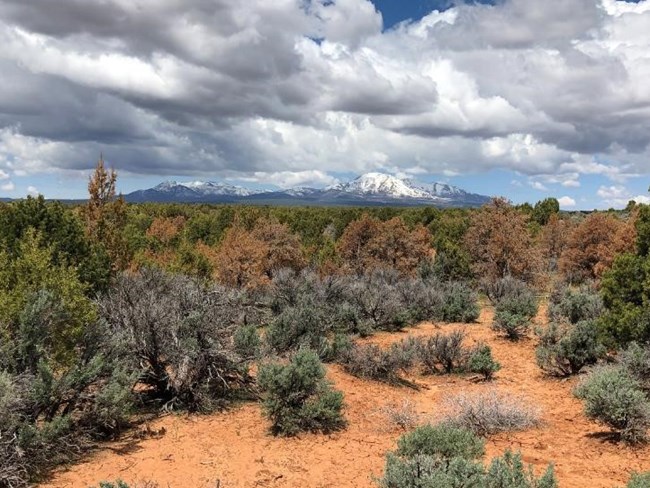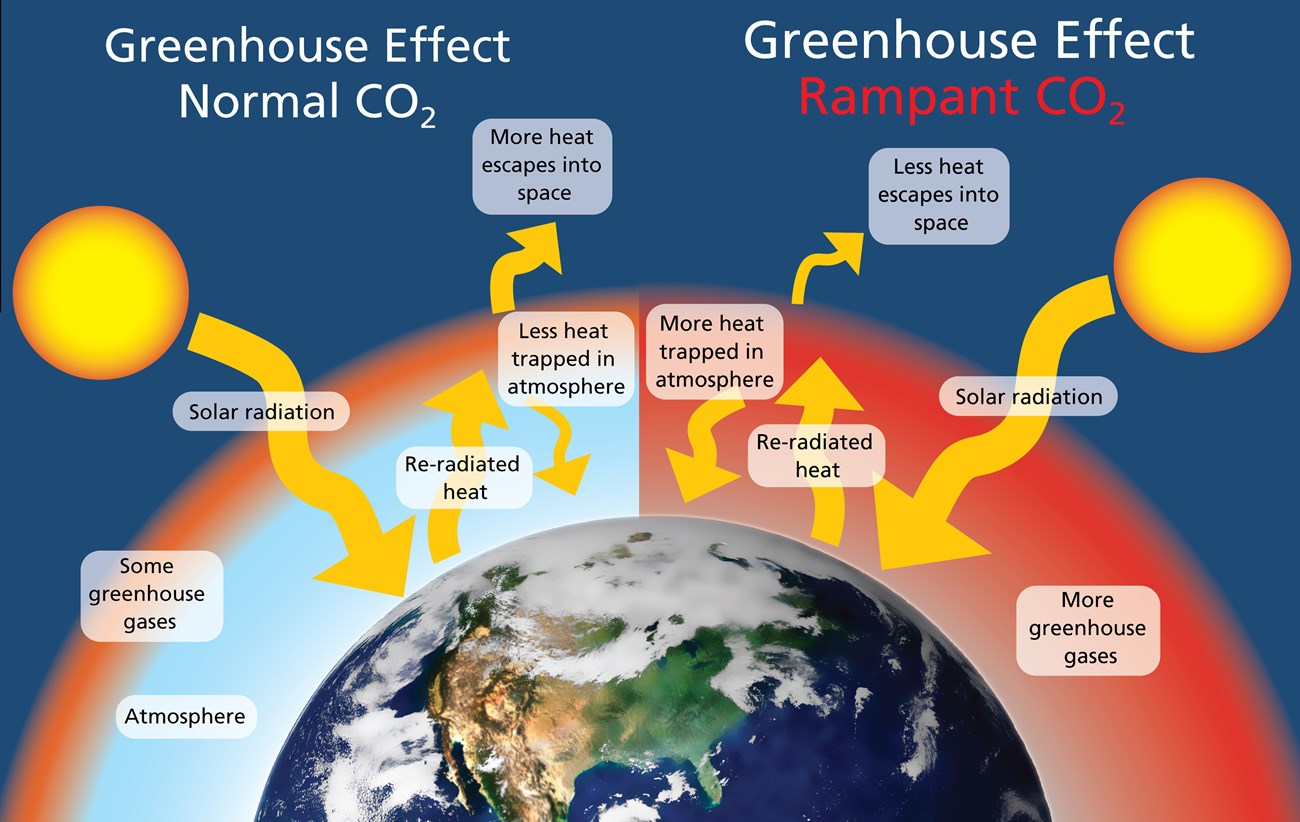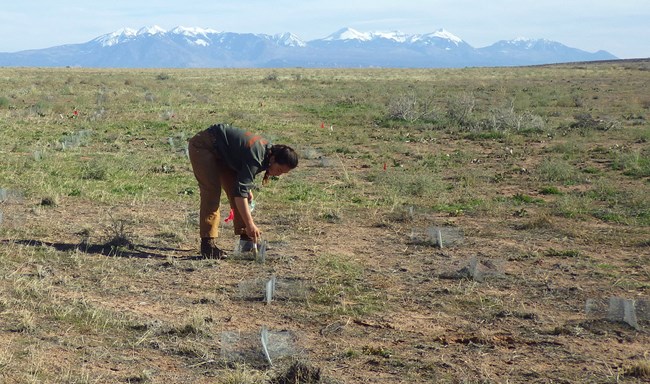
Climate and Weather
Climate plays a crucial role in driving or regulating many ecological processes. It helps determine which plant species occur where; how nutrients, water, and energy are cycled; and the relationships between soil, plants, and water availability. Climate can also affect the susceptibility of an ecosystem to myriad disturbances, such as floods, drought, and wildfire.
Plants and animals are adapted both to the short-term variability of weather and to the long-term climate conditions in the places where they live. But if extreme weather or changes in climate exceed their ability to cope, they will move, suffer, or perish. Both weather and climate help shape the distribution of plants and animals across the landscape. For example, weather conditions affect wildfires, the timing and volume of streamflow, and plant growth. Climate, such as hot, arid conditions on a high plateau, affects which plants and animals live there and how quickly they grow and reproduce.
Climate and Weather: What's the Difference?
“Climate is what you expect. Weather is what you get.” Weather and climate describe the same thing—the state of the atmosphere—but at different time scales. Weather is what you experience when you step outside on any given day. In other words, it is the state of the atmosphere at a particular location over the short-term. Climate is the average of the weather patterns in a location over a longer period of time, usually 30 years or more. When we talk about climate change, we are talking about changes in long-term averages of daily weather; if most days are warmer, then the long-term average will be warmer.
Climate Monitoring
Because climate, weather, and natural resource vital signs are all intricately linked, the Northern Colorado Plateau Network studies them simultaneously. Understanding how park vital signs responded to past conditions provides clues about how they may respond in the future. We track climate using weather station data from network parks. But climate is more than just temperature and precipitation, so we also calculate “water balance”—the amount of water available for use by plants. Real-time weather and water balance conditions, along with historical summaries, are reported through an interactive website, The Climate Analyzer.
Water Balance
Plants don’t “drink” rain; they use water from soil taken up by their roots. So instead of just recording how much water falls from the sky, it’s important to determine how much of that water is actually available to plants at any given time. Starting with the total precipitation, NCPN staff use a model to subtract runoff, drainage, and evaporation. The remaining water, stored in soil, can be used by plants. Tracking how precipitation moves through the environment in its different forms (liquid, solid, gas) has improved our understanding of vegetation response to past weather and climate patterns. This in turn has vastly improved our ability to understand potential climate-change impacts to plants and animals in parks.
Climate Change
Twenty-first century climate change is unique in its magnitude, pace, and projected impacts. Scientists attribute the global warming trend observed since the mid-20th century to the human expansion of the "greenhouse effect:" warming that results when the atmosphere traps heat radiating from Earth toward space. On Earth, human activities are changing the natural greenhouse. Over the last century, the burning of fossil fuels like coal and oil has increased the concentration of atmospheric carbon dioxide (CO2). This happens because the coal or oil burning process combines carbon with oxygen in the air to make CO2. To a lesser extent, the clearing of land for agriculture, industry, and other human activities has increased concentrations of greenhouse gases. The consequences of changing the natural atmospheric greenhouse include warmer average temperatures, more extreme weather events, sea level rise, shifts in ocean circulation and chemistry, and increased drought stress. These impacts can strengthen and amplify one another.

|
Left: Carbon dioxide (CO2), methane (CH4), and nitrous oxide (N2O) are created by normal life processes, trapping some of the sun's heat and preventing the planet from freezing.
Right: The rampant emission of CO2 from burning fossil fuels traps excess heat, leading to increases in average temperature and a cascade of other effects. The solution is to reduce human activities that emit heat-trapping gases.
Graphic: NPS/William Elder |
Climate change is no longer a future threat. On the Northern Colorado Plateau, we are currently seeing its consequences reflected in changes to vegetation and water resources. In the future, the Northern Colorado Plateau will likely get warmer and drier, because potential increases in precipitation will likely be offset by warming temperatures that will increase evaporation rates and water use by plants ("evapotranspiration"). Climate change will affect the distribution of plants and animals in parks, which will change how ecosystems work. All of the natural resource vital signs in NCPN parks are affected by climate change.

To help park managers prepare for these and other changes, the NCPN and its partners, such as the NPS Climate Change Response Program, are helping park managers to determine the sensitivity of park resources to a changing climate. For instance, our work is helping managers know which types of plants may be more resilient to projected climate changes. Understanding where and what to plant as the climate gets drier—and where and what to let go—will help managers decide which plant communities to prioritize for restoration, so parks don’t waste time and money planting species that are unlikely to survive. Adaptive decision making like this is part of a process called Climate Smart Conservation, which helps land managers understand sensitivity to climate, identify adaptation strategies, and implement those likely to reduce vulnerabilities and meet forward-looking management goals. Network staff are actively helping parks engage in this process.
With tools provided by The Climate Analyzer, we can also do forecasting and nowcasting of vegetation condition a few months into the future based on our understanding of how vegetation response lags weather conditions. Park managers could use this model to help predict the months and years in which projects that depend on good growing conditions might be most likely to succeed. The model may also help predict the short-term impacts of drought on vegetation.
Learn more about the causes and effects of climate change at these web sites:
- NPS Climate Change subject site
- The Intergovernmental Panel on Climate Change
- U.S. Climate Change Science Program
- NASA Global Climate Change Program
- NOAA climate change hub
- USGS Western Geographic Science Center
Vital Signs: Climate and weather
Protocol Lead: David Thoma
Quick Reads
- Arches National Park
How Dry Will Parks Get? Water Deficit Tells Us
- Locations: Arches National Park, Bryce Canyon National Park, Canyonlands National Park, Capitol Reef National Park, Dinosaur National Monument, more »
- Offices: Inventory and Monitoring Division, Northern Colorado Plateau Inventory & Monitoring Network

Good, clean water is essential for healthy ecosystems--for people, vegetation, and animals--making it one of the most important resources in the semi-arid west. The Northern Colorado Plateau Network and its partners monitor water quality in 8 national parks in Utah and Colorado to help scientists and managers conserve these resources. This article summarizes 2019-2022 water quality data and how they compare to state standards.
- Locations: Bryce Canyon National Park
- Offices: Inventory and Monitoring Division, Northern Colorado Plateau Inventory & Monitoring Network

Have you wondered what will happen to vegetation in arid climates if they become more arid in the future? Northern Colorado Plateau Network scientists explored the relationships between climate and vegetation at Bryce Canyon National Park. Results include discovery of changes that have already occurred and identification of vegetation types that are most sensitive to continued climate change, providing managers with insights into future scenarios that can aid decision making.
- Locations: Acadia National Park, Agate Fossil Beds National Monument, Alibates Flint Quarries National Monument, Amistad National Recreation Area, Antietam National Battlefield, more »
- Offices: Appalachian Highlands Inventory & Monitoring Network, Chihuahuan Desert Inventory & Monitoring Network, Cumberland Piedmont Inventory & Monitoring Network, Eastern Rivers and Mountains Inventory & Monitoring Network, Great Lakes Inventory & Monitoring Network, more »

Across the US, changes in water availability are altering which plants grow where. These changes are evident at a broad scale. But not all areas experience the same climate in the same way, even within the boundaries of a single national park. A new dataset gives park managers a valuable tool for understanding why vegetation has changed and how it might change in the future under different climate-change scenarios.
- Locations: Arches National Park, Black Canyon Of The Gunnison National Park, Bryce Canyon National Park, Canyonlands National Park, Capitol Reef National Park, more »
- Offices: Inventory and Monitoring Division, Northern Colorado Plateau Inventory & Monitoring Network

Birds of the desert southwest, a climate-change hotspot, are among the most vulnerable groups in the US. To help park managers plan for those changes, scientists evaluated the influence of water deficit on landbird communities at 11 national parks in Utah and Colorado. The results will help land managers to focus conservation efforts on places where certain species are most vulnerable to projected climate changes.
- Locations: Capitol Reef National Park
- Offices: Inventory and Monitoring Division, Natural Resource Stewardship and Science Directorate, Northern Colorado Plateau Inventory & Monitoring Network
- Locations: Capitol Reef National Park
- Offices: Inventory and Monitoring Division, Natural Resource Stewardship and Science Directorate, Northern Colorado Plateau Inventory & Monitoring Network
Although groundwater levels remain shallow enough to support mature cottonwood trees, the Fremont River in Capitol Reef National Park may be at risk for progressively lower flows over time—reducing the flooding needed for new cottonwood recruitment. Find out why—and what else the Northern Colorado Plateau Network is learning about the park’s riparian systems—in this article.
- Locations: Hovenweep National Monument
- Offices: Inventory and Monitoring Division, Natural Resource Stewardship and Science Directorate, Northern Colorado Plateau Inventory & Monitoring Network

Springs are naturally and culturally important at Hovenweep National Monument. Through long-term monitoring, the Northern Colorado Plateau Network is tracking the health of three spring systems across time here. Some sites are proving more resilient than others in the face of prolonged drought and rising temperatures. But there are actions park managers can take to help conserve these resources as the climate continues to change.
- Locations: Arches National Park, Black Canyon Of The Gunnison National Park, Bryce Canyon National Park, Canyonlands National Park, Capitol Reef National Park, more »
- Offices: Inventory and Monitoring Division, Northern Colorado Plateau Inventory & Monitoring Network

Scientists from the Northern Colorado Plateau Network travel thousands of miles each year to collect data on plants, soils, and water across network parks. But it would be impossible to cover every square inch of the Northern Colorado Plateau with boots on the ground. Instead, we simultaneously monitor the parks with boots in space—satellite data that provide information at a much broader scale.
- Locations: Arches National Park, Aztec Ruins National Monument, Bandelier National Monument, Bent's Old Fort National Historic Site, Big Bend National Park, more »
- Offices: Chihuahuan Desert Inventory & Monitoring Network, Climate Change, Climate Change Response Program, Inventory and Monitoring Division, Mediterranean Coast Inventory & Monitoring Network, more »

When the climate changes enough, the vegetation communities growing in any given place will also change. Under an expanded bimodal climate zone, some plant communities in western national parks are more likely to change than others. National Park Service ecologists and partners investigated the future conditions that may force some of this change. Having this information can help park managers decide whether to resist, direct, or accept the change.
Publications and Other Information
Source: Data Store Collection 4266. To search for additional information, visit the Data Store.
Source: Data Store Saved Search 472. To search for additional information, visit the Data Store.
Source: Data Store Saved Search 449. To search for additional information, visit the Data Store.
Source: Data Store Collection 2543. To search for additional information, visit the Data Store.
Last updated: November 7, 2024



